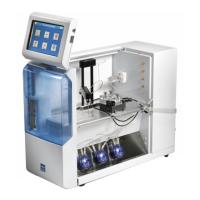103
8.2.2 Ethanol/Ethanol-HC
This is a direct reading of Ethanol in solution at the enzyme sensor. The enzyme Alcohol Oxidase is immobilized in the
enzyme membrane.
Ethanol + O
2
Alcohol Oxidase
H
2
O
2
+ Acetaldehyde
Ethanol
HC
Buffer
YSI 1579 YSI 2787
Std
YSI 2790 YSI 7151
Std
YSI 2790 YSI 7151
Color
Green Magenta
Location
(Tube holder)
Range
g/L
g/L
n Point
2.00 g/L 25.0g/L
Check
Point
3.20 g/L 40.0 g/L
Size
15 µL
Precision
(CV,n=10)
g/L,
whichever
is greater
g/L,
whichever
is greater
Linearity
(0.04 to Cal
Point)
±5%
(Cal Point to
Range Max)
(0.5 to Cal
Point)
±5%
(Cal Point to
Range Max)
Working
Life
5 days
Note: See Appendix B – Concentration
Unit Conversion if concentration unit
conversion is required.
• The linear range of ethanol is quite limited. If you are
concerned about linearity, monitor the upper range of
concentration on a regular basis. You may benefit by
preparing and using a calibrator with an ethanol
concentration close to your sample concentration.
• If you prepare your own ethanol calibrator, prepare a
solution with ionic strength. Level sensing depends on a
conductive solution. A 0.1% K
2
EDTA solution as a diluent
acts as both a conductive solution and a preservative.
Normal saline solution (0.9%) is also an acceptable
diluent.
• Your sample should be methanol-free. Methanol can
be a significant interference, since it is a good substrate
for Alcohol Oxidase. Propanol and butanol are very weak
substrates of Alcohol Oxidase and usually do not present
an interference problem.
• Controlling evaporation of ethanol from both sample and
calibrator is important. The use of some type of test tube
cover (eg., prepunctured film) will help. Frequently
replacing the calibrator solution with fresh solution will
also minimize the effects of evaporation on measurement
integrity.

